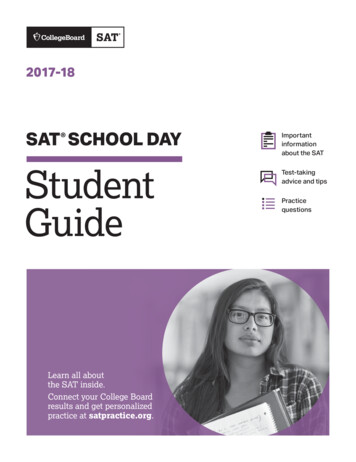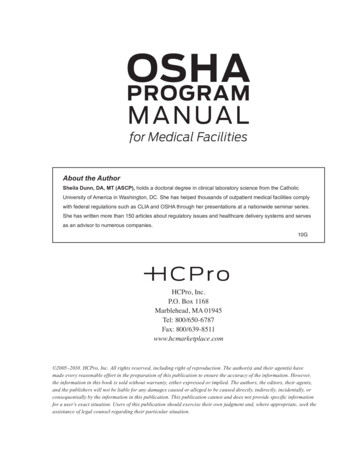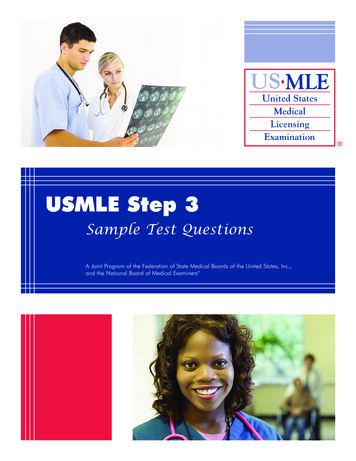
Transcription
aryRead to Perform a TaskDemonstrate GeneralUnderstandingDevelop an InterpretationExamine Content andStructure: Informational TextExamine Content andStructure: Literary Text
It is the policy of the State Board of Education and a priority of the Oregon Department of Educationthat there will be no discrimination or harassment on the grounds of race, color, sex, marital status,religion, national origin, age or handicap in any educational programs, activities, or employment.Persons having questions about equal opportunity and nondiscrimination should contact the StateSuperintendent of Public Instruction at the Oregon Department of Education.Office of Assessment & Information ServicesOregon Department of Education255 Capitol Street NESalem, OR 97310(503) 947-5600Susan CastilloState Superintendent of Public InstructionDoug KostyAssistant SuperintendentKen HermensLanguage Arts Assessment SpecialistJames LeighMathematics Assessment SpecialistSteve SlaterManager, Scoring, Psychometrics and ValidityDianna CarrizalesDirector, Monitoring, Systems, and OutcomesKathleen VanderwallManager, Test Design and AdministrationBradley J. LenhardtMonitoring and Assessment SpecialistHolly CarterAssessment Operations and Policy AnalystSheila SomervilleElectronic Publishing SpecialistMichelle McCoyELPA and Assessment Implementation SpecialistKathy BusbyProject Manager
Reading and Literature DIRECTIONSRead each of the passages. Then read the questions that follow and decide on the BESTanswer. There are a lot of different kinds of questions, so read each question carefullybefore marking an answer on your answer sheet.A TIME OF CHANGERead the following selection by author Scott O’Dell that describes the transformation of acanyon in Arizona called Canyon de Chelly.ON THE HIGH MESAS above our canyon spring came early thatyear. The piñon trees shook off their coverings of snow in themonth of the deer. Warm winds melted the snowand blue water gathered under the trees and ranthrough the meadows and down the steepbarrancas. Far to the north, where the stone wallsof the canyon stand so close together that youcan touch them with your outstretched hands,the waters met and flowed toward the south, past Spider Rock andLost Sheep Mountain, at last in a big loop past our village.The day the waters came was a wonderful day. I heard the firstsounds of their coming while I lay awake in the night. At first itwas a whisper, like a wind among the dry stalks of our cornfield.After a while it was a sound like the feet of warriors dancing. Thenit was a roar that shook the earth. I could hardly wait until the sunrose. When the first light showed in the east, I hurried out to see theriver running. My father and mother and my sister, Lapana, hadseen early springs many times before, so they were sleeping.I stood alone in the orchard, where the peaches grow. It was amiracle. Yesterday there was nothing to see save bare trees andwide stretches of yellow sand. In one night everything hadchanged. The trees had begun to bud and the sand lay deep underblue, rushing water.I felt like singing. I wanted to leap and dance with joy, yet Istood quietly and watched the river running between the greeningcottonwood trees.Office of Assessment and Information ServicesOregon Department of Education12011-2013 Sample Test, Grade 6August 2011
Reading and Literature 1Why did the narrator most likely stand quietly instead of leaping and dancing?A. She‟s not as happy as she first thought.B. She‟s afraid her father will be angry.C. She doesn‟t know how to dance.D. She doesn‟t want to ruin the moment.2The mood of this selection is set mostly through theA. setting.B. dialogue.C. plot.D. characters.3“It was a miracle. Yesterday there was nothing to see save bare trees and wide stretchesof yellow sand. In one night everything had changed.” This statement shows that thenarrator isA. excited about the change in season.B. confused about the changes in the orchard.C. surprised that there hasn‟t been a bigger change.D. frightened by how much everything has changed.4What did the narrator hear while she lay awake in the night?A. A person‟s whisperB. Rain on the roofC. Warriors dancingD. The oncoming waters5The narrator says “Yesterday there was nothing to see save bare trees.” In this sentence,the best synonym for save would beA. rescue.B. pretend.C. except.D. without.Office of Assessment and Information ServicesOregon Department of Education22011-2013 Sample Test, Grade 6August 2011
Reading and Literature STITCH ’ER UP!It takes more than horses, cows, cowboys, and cowgirls to make a rodeo. Meet MollyClaussen, a seamstress from Gaston, Oregon, who sews rodeo outfits. THE NEWBERGGRAPHIC newspaper tells about her interesting job.THE CROWD YELLS, the horses gallop in and the girls wear smileson their faces representing the St. Paul Rodeo, but they also sparklein the sunlight from their custom made outfits by seamstress MollyClaussen.Horses and rodeos have been a part of Claussen‟s life for manyyears, but it wasn‟t until she used her sewing abilities to make outfitsfor her granddaughter, Stephanie, who was into “rodeo queening”that the hobby took on a new life.“I have always sewed,” she said. “My mother was a goodseamstress and I made my own wedding dress when I gotmarried and did all the family‟s sewing. I made my ownclothes and my daughters‟—I made their prom dresses.”Claussen, who lives in Gaston, began sewing for rodeocourts after retiring from management in the state‟s courtsystem in Hillsboro five years ago. She is now entering herthird year of sewing for the St. Paul Rodeo court.In addition, Claussen is kept busy sewing for the MissRodeo Oregon competition, and courts for the ClackamasCounty Rodeo, Molalla Buckaroo, Salem Rodeo, and others.“It seems like it‟s pretty much year-round now,”Claussen said. “Miss Rodeo Oregon vies in December forMiss Rodeo America and I sewed up until December . . . (then) wetry to take a few weeks off.”This year Claussen began sewing in February and has continuednonstop. She finished one deadline for the Rose Parade two daysprior to the event. With rodeo courts doing their coronations earlierin the year she is better able to schedule the girls for all of theirfittings and meet all of her deadlines.Claussen gets help from her partner, Jerry Hall, who does theembroidery work at their business, located in Claussen‟s home,Country Stitchin‟.“I had no idea what call there was for a seamstress,” Claussensaid. “I also do sewing for people who show horses. I was surprisedOffice of Assessment and Information ServicesOregon Department of Education32011-2013 Sample Test, Grade 6August 2011
Reading and Literature about how much sewing there really is. I love doing it. You don‟tmind putting in the hours if you love the work you are doing.”Although every rodeo is different, St. Paul annually needs threeoutfits for the court. Claussen works on the clothes up until thequeen‟s coronation in May.Each woman has an arena outfit with chaps, a dress outfit forpublic appearances and a trail shirt. The items are made to mix andmatch so as not to clash with each other. It also takes a special way ofdesigning the outfits in order for the women to be able to maneuverin them.“Our family grew up with horses and rodeo and I knew what ittook to make things pretty and to be able to ride a horse in it,” shesaid.Generally, the St. Paul Rodeo prefers what Claussen calls retroWestern wear. Because she had purchased an industrial sewingembroidery machine and the couple also sews caps and jackets withit, she has been able to use it to sew on leather, adding fringe andsparkles.This year Claussen did something new by adding embroidery onthe court‟s chaps with chapmaker Ken Coleman of St. Paul. The twoworked together to design the chaps and Claussen embroidered onthe heavy leather creating a dramatic effect.But the seamstress approaches her work as more than just sewinga few outfits.“It has to be a gift; like a painter when he‟s painting a picture, it‟sa feeling and a creation,” she said. “I can use my creativity and I liketo make pretty things. I like to sew pretty fabrics and add stones andbeads.”Claussen also designs the clothing with inspiration frommagazines and pageants; she also gets help from the womenthemselves. One year a girl even gave Claussen the outfit hergrandmother wore while in the court and she was able to make ashirt from it.After all the sewing is complete, the seamstress is able to enjoythe rodeo and admire her hard work. This was the first year the St.Paul Rodeo held a style show in which Claussen‟s work wasfeatured, among others.“It was so much fun,” she said. “When you see a woman on stagewith your creation on you say, „well, that turned out nice.‟”Office of Assessment and Information ServicesOregon Department of Education42011-2013 Sample Test, Grade 6August 2011
Reading and Literature 6Claussen said, “I had no idea what call there was for a seamstress.” The word seamstressrefers to someone whoA. rides in rodeos.B. wears sparkling clothing.C. designs rodeo saddles.D. makes outfits.7It is challenging to make clothing for a rodeo court. The main challenge is becauseA. so much material is needed to make everything match.B. it is difficult to design patterns that will please the audience.C. finding times for fittings is difficult because the girls are so busy.D. outfits need to go together and be easy to move in.8The article states that an arena outfit consists of all of the following EXCEPTA. chaps.B. a dress outfit.C. denim jeans.D. a trail shirt.9Molly Claussen is successful at designing rodeo wear because sheA. has sewn prom dresses.B. is retired from her regular job.C. has had experience with horses and rodeo.D. has an industrial sewing embroidery machine.10Molly began sewing this type of outfit afterA. her mother talked her into sewing.B. sewing for her granddaughter.C. her partner had the idea for embroidery.D. she got ideas from magazines.Office of Assessment and Information ServicesOregon Department of Education52011-2013 Sample Test, Grade 6August 2011
Reading and Literature YOUR BODY AT WORKWhy do babies have more bones than adults? What gland is responsible for makingsweat? The answers to these questions and more are found in the selection below.IF YOU COULD PEEK INSIDE YOUR OWN BODY what would you see?Hundreds of bones, miles of blood vessels and trillions of cells, all ofwhich are constantly working together.Office of Assessment and Information ServicesOregon Department of Education62011-2013 Sample Test, Grade 6August 2011
Reading and Literature 11The vertebrae in your spine areA. flat bones.B. long bones.C. irregular bones.D. short bones.12Which kind of gland is located in the epidermis?A. EndocrineB. OilC. SalivaryD. Sweat13What helps to move oxygen around our bodies?A. CellsB. MusclesC. SkinD. Glands14According to this selection, which statement is true?A. Adults have fewer cells than a newborn baby.B. Adults have fewer bones than a newborn baby.C. Less than half of the muscles in your body are skeletal muscles.D. The main job of glands is to provide your body with food and oxygen.CONTINUE ON TO THE NEXT PAGEOffice of Assessment and Information ServicesOregon Department of Education72011-2013 Sample Test, Grade 6August 2011
Reading and Literature JOSIE’S RIDEThis passage is taken from Celia Barker Lottridge’s novel called WINGS TO FLY. A younggirl named Josie is fascinated by a little wooden house that sits in the middle of nowhere.Read the selection to discover the story behind the house.“WHOA, GINGER,” SAID JOSIE.The sturdy bay pony halted in the dusty wagon track. She wasused to resting for a moment in this spot because Josie alwaysstopped here to look across the fields at the silver house. Eventoday when her brother Sam was far ahead of her in a tearing hurryto get to town, she could take just a minute to admire it.The silver house stood all alone on a small rise of ground. Itdidn‟t have even a chicken house to keep it company or a path toinvite a traveler to its door. Nothing around it moved except theprairie grass stirring gently in the hot wind. Today it seemed toJosie that the house was just lightly settled on the earth like a biggray bird. At any moment it might spread its wings and slowly flyaway, back to a place where such houses were common.Of course the house was not really silver. It was built ofunpainted boards that had weathered to a soft,silvery gray. The house Josie lived in was built ofweathered wood, too, but nails had been poundedinto it, snowballs thrown against it, andclotheslines attached to it. It looked like a housethat had been well used for three years by fivepeople, and by horses who loved to rub against itto get the flies off.But no one had ever lived in the silver house.Josie knew the story. Mr. Ranald McLeod had come to the Curlewdistrict from Ontario just like thousands of other homesteaders. Hehad worked for three years to prove up his claim and build a housefor his bride who would come from back east as soon as it wasfinished. Josie thought that he must have loved her very much,because he had built a fine house. It wasn‟t big—no homesteadercould afford the lumber for a big house—but it was not a one-storybox like the other houses around Curlew. It had an upstairs withOffice of Assessment and Information ServicesOregon Department of Education82011-2013 Sample Test, Grade 6August 2011
Reading and Literature two dormer windows, one in front and one in back, as well as curlygingerbread trim under the eaves, and a wide front porch.On a hot day like this, Josie liked to imagine sitting on thatporch with a glass of cool lemonade in her hand, looking out overthe wide prairie landscape. There would be no chores to do, no oneto hustle her out to pump water or bring in the washing.Josie heard hoofbeats and looked down the track. It was Sam, ofcourse.“The train will be here in five minutes,” he said. “We shouldn‟tbe wasting time.”“I know,” said Josie. She pressed her bare heels into Ginger‟sround sides and the pony reluctantly started trotting at a gentlepace. Sam turned King and rode alongside.Sam looked over at Josie. “Why do you like to look at that houseso much?” he asked idly.Josie thought for a minute. “It‟s special,” she said. “It‟s like ahouse from far away that got here accidentally. And it‟s so sad thatMr. McLeod doesn‟t live in it. Somebody should. It‟s the best housearound here.”She didn‟t tell Sam that she always thought of Mr. McLeod‟slost bride. She was the sad part of the story of the house. Not thatshe had died. No, she had come from Ontario when the house wasready, down to the fancy brass doorknobs. She arrived at Curlewstation with her trunks. Mr. McLeod met her, of course, and droveher straight out to the house.People said that she sat in the wagon for a long time and lookedat the little wooden house and the land around it, flat and treelessas far as the eye could see. Then she said, “I can‟t live here. Take meback to the station.” She took the next train east to Ontario, and Mr.McLeod never went into the house again. He still lived in aboarding house in town and came along this very track to farm hisland, but he left the house alone.Josie wondered whether his bride ever thought of him now. Didshe ever wish she had given the house a chance?Office of Assessment and Information ServicesOregon Department of Education92011-2013 Sample Test, Grade 6August 2011
Reading and Literature 15Based on how it is used twice in paragraph five, what does the word homesteadermean?A. A supplier who provides materials for new homesB. An individual who makes a home in a new landC. A person who builds homes for others to live inD. An area of land where new homes are built16All of the following are differences between Josie‟s house and the silver house EXCEPTA. the number of people living in the house.B. the number of stories or floors in the house.C. the material that the house was made of.D. the amount of activity around the house.17Based on events so far, what is most likely to happen later in the story?A. Josie will try to find out more about the silver house.B. Sam will suggest the family should move to the silver house.C. Mr. McLeod will decide to leave and will sell the silver house.D. Another woman from Ontario will come to live in the silver house.18What is the main reason the author includes the description of Josie‟s house?A. To set up a contrast with the silver houseB. To build sympathy for the main characterC. To explain the effects of weather in the areaD. To provide important development of the plot19Why does the author compare the house to a big gray bird that “might spread its wingsand slowly fly away”?A. To suggest that the house is beautiful but poorly builtB. To create tension about whether the house is really thereC. To emphasize how the house seems misplaced in this settingD. To bring a humorous tone that adds variety to this part of the storyOffice of Assessment and Information ServicesOregon Department of Education102011-2013 Sample Test, Grade 6August 2011
Reading and Literature THE MYSTERIOUS LOCH NESS MONSTERIs the monster in the loch a myth? Not nessie-sarily! Read on to learn the history of thismysterious creature.SUNLIGHT DANCES DOWN THE BLUE expanse of Loch Ness. A lightbreeze stirs the water where Castle Urquhart guards the curve of thebay. It is a fine, calm day to launch a boat or cast a line. Or is it?Is something out there? An upturned boat? A log? A mass ofwater plants? Or could it be Nessie—the fabled Loch Ness Monster?For centuries, debate has raged over whether a huge, unknowncreature inhabits this mysterious loch—largest, longest, and deepestof three lakes threading Scotland‟s wildly beautiful Great Glen.Vikings may have been first to ask the question. Their mythologytells of “water horses” in Scotland‟s lochs. The first written accountof a lake creature dates back to the sixth century when, says anancient Latin text, a swimmer was killed by a frightful beast near theloch‟s north end. St. Columba, on hearing of the attack, rowed outand scolded the monster so severely that never since has it beenknown to repeat such a misdeed.Rumors and whisperings of a “horrible great beastie” continued,century after century. But they were spoken in hushed tones and notoften when strangers were about. In the 1930s, however, word of theLoch Ness Monster began to spread. Nessie made a big splash in1934 when Rupert Gould, a respected scientific writer, published abook called The Loch Ness Monster and Others.Residents and visitors to the loch began coming forward withstories of sightings, some from earlier times. An elderly gentlemanwrote to Gould, recalling that about 1871 he saw something “like anupturned boat.wriggling and churning up the water.” In a startlingland encounter, a London couple driving home from a holiday in1933 saw an enormous, black “prehistoric animal” loom in front ofthem, then shuffle into the loch.Stories grew more dramatic, descriptions more specific. Theimage of Nessie with long neck, multiple humps, and long tailemerged.Office of Assessment and Information ServicesOregon Department of Education112011-2013 Sample Test, Grade 6August 2011
Reading and Literature The first photo of Nessie was snapped by a workman whowatched “an object of considerable dimensions” rise out of the darkloch. His photo is believed to be authentic, but it is too blurry toprove anything. A clearer (but, as it turned out, much less authentic)shot of Nessie labeled “the surgeon‟s picture” was produced byRobert Wilson, a London doctor. Although years later the photo wasproven to be a hoax, it remains the best known likeness of Nessie.Hoaxes (and, possibly, hallucinations) aside, the case for a realNessie continued to grow.Researchers began using moderntools to find an answer to the riddle.In the 1970s, a team of scientists usedsonar to track two objects, 20 to 30 feetlong, and photographed them with anunderwater camera. A photo showedwhat looked like a big flipper with abulky, rough-textured body.Although debate still rages,emphasis seems to have shifted fromtrying to prove whether Nessie existsto determining what she could be. Cryptozoologists (scientists whostudy mysterious animals) suggest it might be a primitive snakelikewhale called zeuglondon, a long-neck seal, or a school of giant eels.Prevailing opinion, however, favors the idea that Nessie is aplesiosaur, a descendant of dinosaurs long thought extinct butsomehow able to survive in the deep loch. Undoubtedly, of course,Nessie is not alone. To have survived for so many centuries, she mustbe part of a breeding family. In fact, more than one creature has beenseen at once—although such sightings are rare.The mystery is far from being solved. No one theory fits all data.Scientists even argue about what is actually “data.” No body or bodyparts identified with the monster have ever been found. And ancientmyth may be, after all, simply myth.But some photos and films do appear to be authentic. ReportedNessie sightings now number more than 3,000 and counting. Perhapsthere is more truth to those old tales than we imagine after all.Office of Assessment and Information ServicesOregon Department of Education122011-2013 Sample Test, Grade 6August 2011
Reading and Literature 20As the word is used in this article, a likeness isA. something similar.B. a new favorite.C. something larger.D. a better example.21According to the information in the article, which statement is true?A. Every reported sighting of “Nessie” has proven to be a hoax.B. The evidence suggests that there is more than one “Nessie” in the loch.C. Modern scientific equipment has failed to find evidence of “Nessie.”D. Sightings of “Nessie” have decreased over the last few years.22Why were more sightings of “Nessie” reported after Rupert Gould‟s book waspublished?A. More people had cameras to take photographs.B. The book proved that “Nessie” really does exist.C. “Nessie” became more active during the daytime.D. People were more comfortable telling their stories.23The statement from the article that comes closest to revealing the author‟s own opinionon whether Nessie exists isA. “For centuries, debate has raged over whether a huge, unknown creatureinhabits this mysterious loch.”B. “Stories grew more dramatic, descriptions more specific.”C. “His photo is believed to be authentic, but it is too blurry to prove anything.”D. “Perhaps there is more truth to those old tales than we imagine after all.”24Which of the sentences from the article is an opinion?A. “Residents and visitors to the Loch began coming forward with stories ofsightings, some from earlier times.”B. “His photo is believed to be authentic, but it is too blurry to prove anything.”C. “To have survived for so many centuries, she must have been part of a breedingfamily.”D. “No body or body parts identified with the monster have ever been found.”Office of Assessment and Information ServicesOregon Department of Education132011-2013 Sample Test, Grade 6August 2011
Grade 6 Reading/LiteratureSAMPLE TEST KEY 24KeyDAADCDDCCBCDABBCAACABDDCScore Reporting CategoryDevelop an InterpretationExamine Content/Structure Literary TextDevelop an InterpretationDemonstrate General UnderstandingVocabularyVocabularyExamine Content/Structure Informational TextDemonstrate General UnderstandingDevelop an InterpretationDemonstrate General UnderstandingReading to Perform a TaskReading to Perform a TaskReading to Perform a TaskReading to Perform a TaskVocabularyDemonstrate General UnderstandingDevelop an InterpretationExamine Content/Structure Literary TextExamine Content/Structure Literary TextVocabularyDemonstrate General UnderstandingDevelop an InterpretationExamine Content/Structure Informational TextExamine Content/Structure Informational TextCONVERTING TO A RIT SCORENumber correctRIT 4.89216.810218.711220.512222.3*Likely to meet Grade 6 standardsOffice of Assessment and Information ServicesOregon Department of EducationNumber CorrectRIT 236.420239.2**21242.722247.323254.724261.9**Likely to exceed Grade 6 standards142011-2013 Sample Test, Grade 6August 2011
Office of Assessment and Information ServicesOregon Department of Education152011-2013 Sample Test, Grade 6August 2011
Office of Assessment and Information Services 2011-2013 Sample Test, Grade 6 Oregon Department of Education 3 August 2011 STITCH 'ER UP! It takes more than horses, cows, cowboys, and cowgirls to make a rodeo. Meet Molly Claussen, a seamstress from Gaston, Oregon, who sews rodeo outfits. THE NEWBERG










